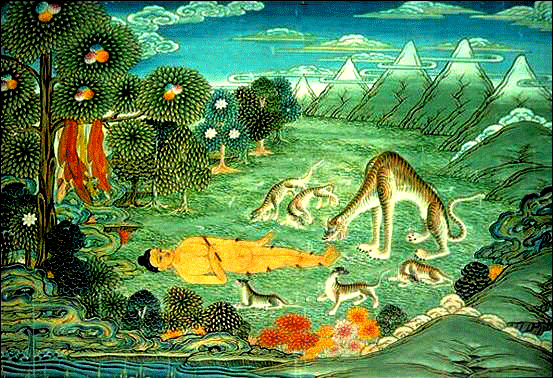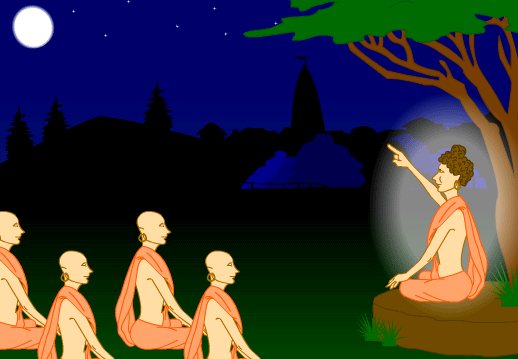Collections of Buddhist legends compiled at various dates in several countries; the oldest and most complete has 547 stories. They were collected before AD 400.
They give an account of previous incarnations of the Buddha, and the verse sections of the text form part of the Buddhist canon. The Jataka stories were one of the sources of inspiration for the fables of Aesop.
JATAKA TALES
जातकमला
Buddhist Legends

The Jātaka Tales (Sanskrit जातक and Pali, Malay: jetaka, Lao: satok) refer to a voluminous body of folklore-like literature concerning the previous births (jāti) of the Buddha. The word most specifically refers to a text division of the Pali Canon of Theravada Buddhism, included in the Khuddaka Nikaya of the Sutta Pitaka. Jataka also refers to the traditional commentary on this book.
The canonical book itself comprises 547 poems, arranged roughly by increasing number of verses. According to Professor von Hinüber, only the last 50 were intended to be intelligible by themselves, without commentary. The commentary gives stories in prose that it claims provide the context for the verses, and it is these stories that are of interest to folklorists. Alternative versions of some of the stories can be found in another book of the Pali Canon, the Cariyapitaka, and a number of individual stories can be found scattered around other books of the Canon.
Many of the stories found in the Jataka have been found in numerous other languages and media — many of them being translations from the Pali but others are instead derived from vernacular traditions prior to the Pali compositions[citation needed].
Sanskrit (see for example the Jatakamala) and Tibetan Jataka stories tend to maintain the Buddhist morality of their Pali equivalents, but re-tellings of the stories in Persian and other languages sometimes contain significant amendments to suit their respective cultures.
Apocrypha
Within the Pali tradition, there are also many apocryphal Jatakas of later composition (some dated even to the 19th century) but these are treated as a separate category of literature from the “Official” Jataka stories that have been more-or-less formally canonized from at least the 5th century — as attested to in ample epigraphic and archaeological evidence, such as extant illustrations in bas relief from ancient temple walls. Some of the apocryphal Jatakas (in Pali) show direct appropriations from Hindu sources, with amendments to the plots to better reflect Buddhist morals.
Buddhism
In Theravada countries, several of the longer Jataka tales are still performed in dance, theatre, and formal (quasi-ritual) recitation to this day, and several are associated with particular holidays on the Lunar Calendar used by Cambodia, Thailand and Laos.
Translations
The standard Pali collection of jatakas, with canonical text embedded, has been translated by E. B. Cowell and others, originally published in six volumes by Cambridge University Press, 1895-1907; reprinted in three volumes, Pali Text Society[2], Bristol. There are also numerous translations of selections and individual stories from various languages.
– source Wikipedia
About Jatak Katha (or Jataka Tales)

All ancient civilizations had taken upon them the responsibility of maintaining moral values in society. Though they had different value systems, yet a common factor in those times was propagating moral teachings through storytelling. In Buddhist communities too, Jataka tales were a major source for inculcating in people a deep sense of moral values. The Jataka tales date back to the third century BC and are considered the oldest form of story-narrating practice. Lack of literacy in those days necessitated the appointment of Jataka storytellers known as Jataka bhanakas. The Jataka bhanakas would travel far and wide to propagate the message of kindness, compassion, generosity, non-violence, self-sacrifice, charity, refrainment from greed etc. through these stories. The Buddha himself used jataka stories to explain concepts like kamma and rebirth and to emphasize the importance of certain moral values.
The Jataka tales depict the Buddha in several of his births in the form of animals. These stories, though simple, are high on moral content considered good for one’s emotional, moral and spiritual health. The Buddha is the protagonist and the central character in each of these stories.
Over a couple of thousand years old, the Jataka tales are just as relevant in content in the modern times. Perhaps, even more so. Living in fragmented and nucleus families, children grow up on a staple diet of violence and other negative traits they pick up from the TV. They do not have the luxury of having the good ol’ granny to educate them with moral teachings imparted by such stories. In cultures where joint family systems are in practice, one would find children well endowed with moral bearings and emotional strength.
The Jataka tales have stood the test of time and will continue to do so, as long as man remains in material pursuit and is led by greed and selfishness.
Changing times have necessitated the use of new technology to narrate these Jataka tales to the young generation, which we have through the medium of animated stories. However, ample care has been taken to project the original messages in these tales without diluting their moral content.
– Source : www.jatakkatha.com




